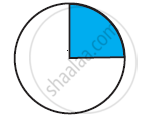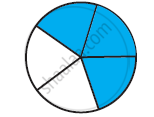Advertisements
Chapters
![NCERT solutions for Mathematics [English] Class 7 chapter 7 - Comparing Quantities NCERT solutions for Mathematics [English] Class 7 chapter 7 - Comparing Quantities - Shaalaa.com](/images/mathematics-english-class-7_6:c3cebe068a194d94b26c11e5078e5928.jpg)
Advertisements
Solutions for Chapter 7: Comparing Quantities
Below listed, you can find solutions for Chapter 7 of CBSE NCERT for Mathematics [English] Class 7.
NCERT solutions for Mathematics [English] Class 7 7 Comparing Quantities EXERCISE 7.1 [Pages 115 - 116]
Convert the given fractional number to percent.
`1/8`
Convert the given fractional number to percent.
`5/4`
Convert the given fractional number to percent.
`3/40`
Convert the given fractional number to percent.
`2/7`
Convert the given decimal fraction to percent.
0.65
Convert the given decimal fraction to percent.
2.1
Convert the given decimal fraction to percent.
0.02
Convert the given decimal fraction to percent.
12.35
Estimate what part of the figure is coloured and hence find the percent cent which is coloured.

Estimate what part of the figure is coloured and hence find the percent which is coloured.

Estimate what part of the figure is coloured and hence find the percent which is coloured.

Find 15% of 250.
Find 1% of 1 hour.
Find 20% of ₹ 2500.
Find 75% of 1 kg.
Find the whole quantity if 5% of it is 600.
Find the whole quantity if 12% of it is 1080.
Find the whole quantity if 40% of it is 500 km.
Find the whole quantity if 70% of it is 14 minutes.
Find the whole quantity if 8% of it is 40 litres.
Convert given percent to decimal fraction and also to fraction in simplest form:
25%
Convert given percent to decimal fraction and also to fraction in simplest form:
150%
Convert given percent to decimal fraction and also to fraction in simplest form:
20%
Convert given percent to decimal fraction and also to fraction in simplest form:
5%
In a city, 30% are females, 40% are males and remaining are children. What percent are children?
Out of 15,000 voters in a constituency, 60% voted. Find the percentage of voters who did not vote. Can you now find how many actually did not vote?
Meeta saves ₹ 4000 from her salary. If this is 10% of her salary. What is her salary?
A local cricket team played 20 matches in one season. It won 25% of them. How many matches did they win?
NCERT solutions for Mathematics [English] Class 7 7 Comparing Quantities EXERCISE 7.2 [Pages 122 - 123]
Tell what is the profit or loss in the following transaction. Also find profit percent or loss percent in given case.
Gardening shears bought for ₹ 250 and sold for ₹ 325.
Tell what is the profit or loss in the following transaction. Also find profit percent or loss percent in given case.
A refrigerator bought for ₹ 12,000 and sold at ₹ 13,500.
Tell what is the profit or loss in the following transaction. Also find profit percent or loss percent in given case.
A cupboard bought for ₹ 2,500 and sold at ₹ 3,000.
Tell what is the profit or loss in the following transaction. Also find profit percent or loss percent in given case.
A skirt bought for ₹ 250 and sold at ₹ 150.
Convert part of the ratio to percentage:
3 : 1
Convert part of the ratio to percentage:
2 : 3 : 5
Convert part of the ratio to percentage:
1 : 4
Convert part of the ratio to percentage:
1 : 2 : 5
The population of a city decreased from 25,000 to 24,500. Find the percentage decrease.
Arun bought a car for ₹ 3,50,000. The next year, the price went upto ₹ 3,70,000. What was the percentage of price increase?
I buy a T.V. for ₹ 10,000 and sell it at a profit of 20%. How much money do I get for it?
Juhi sells a washing machine for ₹ 13,500. She loses 20% in the bargain. What was the price at which she bought it?
Chalk contains calcium, carbon and oxygen in the ratio 10:3:12. Find the percentage of carbon in chalk.
If in a stick of chalk, carbon is 3g, what is the weight of the chalk stick?
Amina buys a book for ₹ 275 and sells it at a loss of 15%. How much does she sell it for?
Find the amount to be paid at the end of 3 years in given case:
Principal = ₹ 1,200 at 12% p.a.
Find the amount to be paid at the end of 3 years in given case:
Principal = ₹ 7,500 at 5% p.a.
What rate gives ₹ 280 as interest on a sum of ₹ 56,000 in 2 years?
If Meena gives an interest of ₹ 45 for one year at 9% rate p.a.. What is the sum she has borrowed?
Solutions for 7: Comparing Quantities
![NCERT solutions for Mathematics [English] Class 7 chapter 7 - Comparing Quantities NCERT solutions for Mathematics [English] Class 7 chapter 7 - Comparing Quantities - Shaalaa.com](/images/mathematics-english-class-7_6:c3cebe068a194d94b26c11e5078e5928.jpg)
NCERT solutions for Mathematics [English] Class 7 chapter 7 - Comparing Quantities
Shaalaa.com has the CBSE Mathematics Mathematics [English] Class 7 CBSE solutions in a manner that help students grasp basic concepts better and faster. The detailed, step-by-step solutions will help you understand the concepts better and clarify any confusion. NCERT solutions for Mathematics Mathematics [English] Class 7 CBSE 7 (Comparing Quantities) include all questions with answers and detailed explanations. This will clear students' doubts about questions and improve their application skills while preparing for board exams.
Further, we at Shaalaa.com provide such solutions so students can prepare for written exams. NCERT textbook solutions can be a core help for self-study and provide excellent self-help guidance for students.
Concepts covered in Mathematics [English] Class 7 chapter 7 Comparing Quantities are Concept of Equivalent Ratios, Conversion between Percentage and Fraction, Converting Decimals to Percentage, Interpreting Percentages, Converting Percentages to “How Many”, Ratios to Percents, Increase Or Decrease as Percent, Basic Concepts of Profit and Loss, Estimation in Percentages, Concept of Proportion, Basic Concept of Percentage, Converting Percentages to Decimals, Profit or Loss as a Percentage, Calculation of Interest, Conversion between Percentage and Fraction, Concept of Ratio, Concept of Unitary Method, Concept of Equivalent Ratios, Conversion between Percentage and Fraction, Converting Decimals to Percentage, Interpreting Percentages, Converting Percentages to “How Many”, Ratios to Percents, Increase Or Decrease as Percent, Basic Concepts of Profit and Loss, Estimation in Percentages, Concept of Proportion, Basic Concept of Percentage, Converting Percentages to Decimals, Profit or Loss as a Percentage, Calculation of Interest, Conversion between Percentage and Fraction, Concept of Ratio, Concept of Unitary Method.
Using NCERT Mathematics [English] Class 7 solutions Comparing Quantities exercise by students is an easy way to prepare for the exams, as they involve solutions arranged chapter-wise and also page-wise. The questions involved in NCERT Solutions are essential questions that can be asked in the final exam. Maximum CBSE Mathematics [English] Class 7 students prefer NCERT Textbook Solutions to score more in exams.
Get the free view of Chapter 7, Comparing Quantities Mathematics [English] Class 7 additional questions for Mathematics Mathematics [English] Class 7 CBSE, and you can use Shaalaa.com to keep it handy for your exam preparation.
